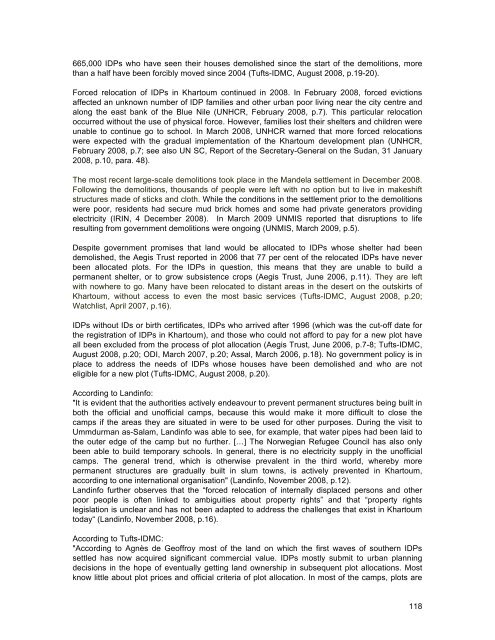SUDAN: Durable solutions elusive as southern IDPs return and ...
SUDAN: Durable solutions elusive as southern IDPs return and ...
SUDAN: Durable solutions elusive as southern IDPs return and ...
Create successful ePaper yourself
Turn your PDF publications into a flip-book with our unique Google optimized e-Paper software.
665,000 <strong>IDPs</strong> who have seen their houses demolished since the start of the demolitions, more<br />
than a half have been forcibly moved since 2004 (Tufts-IDMC, August 2008, p.19-20).<br />
Forced relocation of <strong>IDPs</strong> in Khartoum continued in 2008. In February 2008, forced evictions<br />
affected an unknown number of IDP families <strong>and</strong> other urban poor living near the city centre <strong>and</strong><br />
along the e<strong>as</strong>t bank of the Blue Nile (UNHCR, February 2008, p.7). This particular relocation<br />
occurred without the use of physical force. However, families lost their shelters <strong>and</strong> children were<br />
unable to continue go to school. In March 2008, UNHCR warned that more forced relocations<br />
were expected with the gradual implementation of the Khartoum development plan (UNHCR,<br />
February 2008, p.7; see also UN SC, Report of the Secretary-General on the Sudan, 31 January<br />
2008, p.10, para. 48).<br />
The most recent large-scale demolitions took place in the M<strong>and</strong>ela settlement in December 2008.<br />
Following the demolitions, thous<strong>and</strong>s of people were left with no option but to live in makeshift<br />
structures made of sticks <strong>and</strong> cloth. While the conditions in the settlement prior to the demolitions<br />
were poor, residents had secure mud brick homes <strong>and</strong> some had private generators providing<br />
electricity (IRIN, 4 December 2008). In March 2009 UNMIS reported that disruptions to life<br />
resulting from government demolitions were ongoing (UNMIS, March 2009, p.5).<br />
Despite government promises that l<strong>and</strong> would be allocated to <strong>IDPs</strong> whose shelter had been<br />
demolished, the Aegis Trust reported in 2006 that 77 per cent of the relocated <strong>IDPs</strong> have never<br />
been allocated plots. For the <strong>IDPs</strong> in question, this means that they are unable to build a<br />
permanent shelter, or to grow subsistence crops (Aegis Trust, June 2006, p.11). They are left<br />
with nowhere to go. Many have been relocated to distant are<strong>as</strong> in the desert on the outskirts of<br />
Khartoum, without access to even the most b<strong>as</strong>ic services (Tufts-IDMC, August 2008, p.20;<br />
Watchlist, April 2007, p.16).<br />
<strong>IDPs</strong> without IDs or birth certificates, <strong>IDPs</strong> who arrived after 1996 (which w<strong>as</strong> the cut-off date for<br />
the registration of <strong>IDPs</strong> in Khartoum), <strong>and</strong> those who could not afford to pay for a new plot have<br />
all been excluded from the process of plot allocation (Aegis Trust, June 2006, p.7-8; Tufts-IDMC,<br />
August 2008, p.20; ODI, March 2007, p.20; Assal, March 2006, p.18). No government policy is in<br />
place to address the needs of <strong>IDPs</strong> whose houses have been demolished <strong>and</strong> who are not<br />
eligible for a new plot (Tufts-IDMC, August 2008, p.20).<br />
According to L<strong>and</strong>info:<br />
"It is evident that the authorities actively endeavour to prevent permanent structures being built in<br />
both the official <strong>and</strong> unofficial camps, because this would make it more difficult to close the<br />
camps if the are<strong>as</strong> they are situated in were to be used for other purposes. During the visit to<br />
Ummdurman <strong>as</strong>-Salam, L<strong>and</strong>info w<strong>as</strong> able to see, for example, that water pipes had been laid to<br />
the outer edge of the camp but no further. […] The Norwegian Refugee Council h<strong>as</strong> also only<br />
been able to build temporary schools. In general, there is no electricity supply in the unofficial<br />
camps. The general trend, which is otherwise prevalent in the third world, whereby more<br />
permanent structures are gradually built in slum towns, is actively prevented in Khartoum,<br />
according to one international organisation" (L<strong>and</strong>info, November 2008, p.12).<br />
L<strong>and</strong>info further observes that the “forced relocation of internally displaced persons <strong>and</strong> other<br />
poor people is often linked to ambiguities about property rights” <strong>and</strong> that “property rights<br />
legislation is unclear <strong>and</strong> h<strong>as</strong> not been adapted to address the challenges that exist in Khartoum<br />
today“ (L<strong>and</strong>info, November 2008, p.16).<br />
According to Tufts-IDMC:<br />
"According to Agnès de Geoffroy most of the l<strong>and</strong> on which the first waves of <strong>southern</strong> <strong>IDPs</strong><br />
settled h<strong>as</strong> now acquired significant commercial value. <strong>IDPs</strong> mostly submit to urban planning<br />
decisions in the hope of eventually getting l<strong>and</strong> ownership in subsequent plot allocations. Most<br />
know little about plot prices <strong>and</strong> official criteria of plot allocation. In most of the camps, plots are<br />
118
















